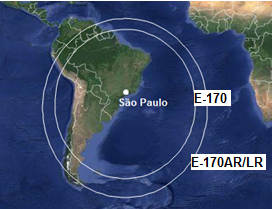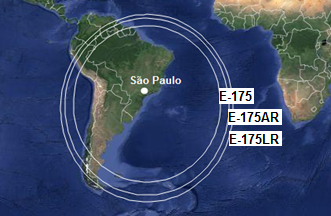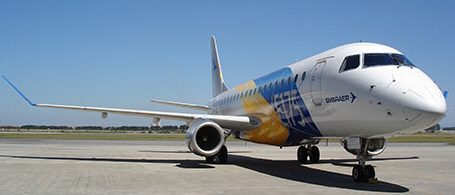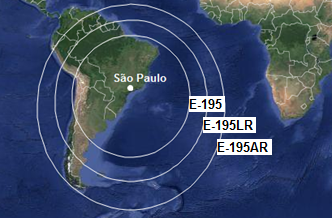
|
|
Embraer E-170
After the
ERJ-145 success, Embraer began to develop a project for larger
aircraft in 1998. While Bombardier choose stretch the CRJ-200, creating the
CRJ-700, CRJ-900 and CRJ-1000, Embraer decided to create a completely new
aircraft. The new jet family was call "E-Jets" (Embraer Jets). Although the
popular name is E-170 (Embraer 170), the official nomenclature still ERJ-170 (Embraer
Regional Jet 170).
A multinational partnerships program developed the E-Jets program. The program
led by Embraer anticipated investments of 850 million dollars and includes
partnerships with 16 world-renowned aerospace industries.
Embraer launched the E-Jet family in June 1999 and the first order was from
Crossair, with a more than 4 billion dollars contract. The first E-170 was
delivery on March 5, 2001 for US Airways Express. Three days later to LOT and
March 10 to Alitalia Express. LOT made the first flight on March 17, between
Warsaw and Vienna.
The E-170 is the smaller version of the family and was the first produced. The
prototype was completed on October 29, 2001 and the first flight was on February
19, 2002. In the initial months the E-170 presented an operationally index of
more than 99%, an exceptional number for any new aircraft.
The E-170 has three different versions: one standard and two with extra fuel
tanks - 170STD, E-170AR and E-170LR.
In June 2013, Embraer launched the E-Jets E2: the second generation of the E-Jet
family. However, the E-170 did not gain a replacement in the new generation, due
to its smaller size, the E-170 was less attractive to airlines than its bigger
brothers, which have more seats and thus lower cost per passenger. The
production ended in 2018, with almost 200 units produced.
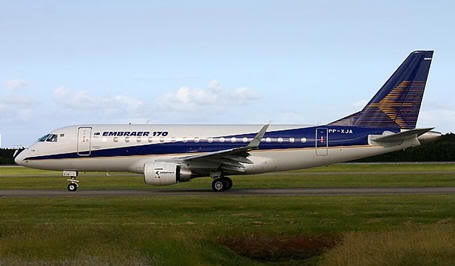 
|
Origin: Brazil
Produced: 2004 - 2018
Length: 29.90 m
Wingspan: 26.00 m
Height: 9.85 m
Aircraft weight: 21.0 tons
Max takeoff/landing weight: 35.9 / 32.8 tons
LR: 37.2 / 32.8 tons
AR: 38.6 / 32.8 tons
Fuel capacity: 7400 liters
Engines: 2x GE CF34-8E
Cruising speed: 850 km/h (Mach 0.80)
Maximum speed: 890 km/h (Mach 0.82)
Service Ceiling: 12.5 km (41,000 ft)
Takeoff Run:
1.64 km
Range: 3334 km / LR: 3889 km / AR: 3892 km
Passengers: 70 to 80
Crew: 4
First flight: 2002
Competitors: CRJ-700, Dash 8-Q400, BAe 146, Avro RJs,
F-70
Launch Customer:
LOT
Cabin width: 2.74 m
Cabin Height: 2.00 m
The E-175 is an elongated version of E-170. The aircraft is also known as
Embraer 170-200 and E-170 as Embraer 170-100. The E-175 is 154 cm longer than
its "little brother" and has 95% commonality with it.
The first sale was for Air Canada, which ordered fifteen units. The first E175
was delivered in July 2005. Only three months later, Embraer was already
delivering the hundredth E-Jet!
The E-170/175 are ideal for replacing old regional jets as Bae 146, Avro RJ's
and Fokker 70.
In 2013 Embraer did an upgrade in E-175, after the release of NextGen CRJs. The
model would be called "E-175 Plus", but Embraer decided to keep Embraer E-175
name to people do not confuse with the new generation E-Jets E2. Like NextGen
CRJs, the "new" E-175 have aerodynamic improvements and Wingtips, reducing fuel
consumption by up to 5%. The first airline to operate it will be American
Airlines.
E-175 became the preferred aircraft model for regional after a change in
the USA regional aviation law in 2012. The number of seats increased from 50 to
76, exactly the capacity of E-175. From 2013 through 2015, Embraer sold no less
than 240 E-175s to regional airlines in the United States, which intend to use
them to expand the fleet and replace CRJ-100/200 and ERJs. The sales boost led
E-175 to overtake the E-190 as the E-Jet Family's best seller.
Operators in Brazil: Azul, Trip
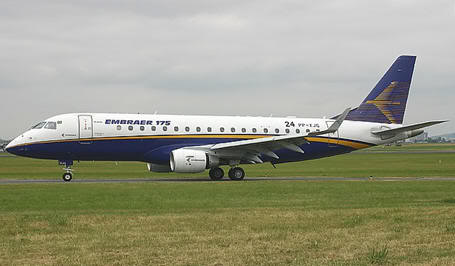 
|
Origin: Brazil
Produced: 2004 - today
Length: 31.68 m
Wingspan: 26.00 m
Height: 9.73 m
Aircraft weight: 21.8 tons
Max takeoff/landing weight: 37.5 / 34.0 tons
LR: 38.7 / 34.0 tons
AR: 40.3 / 34.1 tons
Fuel capacity: 7400 liters
Engines: 2x GE CF34-8E
Cruising speed: 850 km/h (Mach 0.80)
Maximum speed: 890 km/h (Mach 0.82)
Service Ceiling: 12.5 km (41,000 ft)
Takeoff Run: 2.24 km
Range: 3334 km / LR: 3889 km / AR: 3706 km
Passengers: 78 to 88
Crew: 4
First flight: 2002
Competitors: CRJ-700, CRJ-900, BAe 146, Avro RJs,
F-70
Launch Customer:
Air Canada
Cabin width: 2.74 m
Cabin Height: 2.00 m
Built
Embraer stretched E-170
again creating the Embraer 190. The E190 has more than 89% commonality
with E170/175 models or even 95% with the Embraer 195. The E-190 is
taller and longer than E-170/175 and made its first flight on March
2004.
The launching customer was JetBlue, which received the first E-190 in
October 2005 and began its operation in November. Copa Airlines was the
first airline to operate an E-Jet in Brazil. Its E-190 made the first
flight between Panama and Manaus in July 2006.
The E-190 also served as basis for the largest business Embraer jet, the
Lineage 1000.
The E-190 become the most popular version of the E-Jets and allowed Embraer to
dominate no less than 50% of the 100-seat market. The E-190 was the first to
have a replacement: the E190-E2.
Operators in Brazil: Azul, Trip
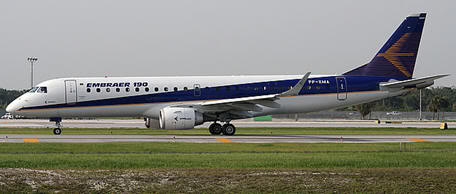  |
Origin: Brazil
Produced: 2005 - today
Length: 36.24 m
Wingspan: 28.72 m
Height: 10.57 m
Aircraft weight: 28.0 tons
Max takeoff/landing weight: 47.7 / 43.0 tons
LR: 50.3 / 43.0 tons
AR: 51.8 / 44.0 tons
Fuel capacity: 10400 liters
Engines: 2x GE CF34-8E
Cruising speed: 850 km/h (Mach 0.80)
Maximum speed: 890 km/h (Mach 0.82)
Service Ceiling: 12.5 km (41,000 ft)
Takeoff Run: 2.05 km
Range: 3334 km / LR: 4260 km / AR: 4448 km
Passengers: 94 to 114
Crew: 5
First flight: 2004
Competitors: CRJ-900, Fokker 100, BAe 146, Avro RJs
Launch Customer:
JetBlue
Cabin width: 2.74 m
Cabin Height: 2.00 m
Also known as Embraer
190-200, the E-195 is the biggest aircraft
manufactured by Embraer until now. The first delivery was to Flybe in September
2006.
Along with JetBlue, Embraer launched the E-Jets AR and LR versions in
2005. The main difference is the range, but those versions also have a
reinforced structure which allow the aircraft take off with more weight.
The E-Jets family was a success worldwide and received orders from
traditional customers of main rival Bombardier, like Air Canada and
Lufthansa. However the E-Jets will face many new competitors.
Manufacturers from China, Russia and Japan, for example, are launching
aircraft to compete directly with Embraer E-Jets. For this and other
reasons, Embraer launched the new generation Embraer E-Jets E2.
In Brazil, Azul was the first airline to operate an E-Jet. The company received
its first E-195 in 2009 and soon became the largest operator of its kind in the
world, with more than 60 units. Azul was also the launcher of the new generation
of the model, the E195-E2.
Operators in Brazil: Azul
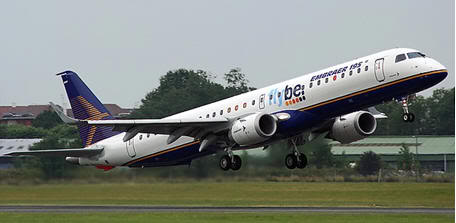 
|
Origin: Brazil
Produced: 2006 - today
Length: 38.65 m
Wingspan: 28.72 m
Height: 10.55 m
Aircraft weight: 28.9 tons
Max takeoff/landing weight: 48.7 / 45.0 tons
LR: 50.7 / 45.0 tons
AR: 52.2 / 45.8 tons
Fuel capacity: 10400 liters
Engines: 2x GE CF34-8E
Cruising speed: 850 km/h (Mach 0.80)
Maximum speed: 890 km/h (Mach 0.82)
Service Ceiling: 12.5 km (41,000 ft)
Takeoff Run: 2.17 km
Range: 2593 km / LR: 3334 km / AR: 4077 km
Passengers: 106 to 122
Crew: 5
First flight: 2004
Competitors: CRJ-1000, Fokker 100, A318, Boeing
717-200, Boeing 737-600
Launch Customer:
FlyBe
Cabin width: 2.74 m
Cabin Height: 2.00 m
Embraer E175-E2
More than ten years after launch the E-Jets, Embraer dominated 50% of
the market of 100 seats. Its main rival, Bombardier, launched largers
jets: the C-Series, to compete with Boeing 737 and A320. In June 2013,
Embraer launched the E-Jets E2: the second generation of the E-Jet
family. The E-Jets E2 incorporate new technologies, new wings, avionics,
cockpit and engines, besides maintaining commonality with previous
generation E-Jets.
The Embraer E175-E2 is the smallest version of the new family and will
replace the E-175. The E175-E2 is longer than the E-175 and may
accommodate more one row seats. Embraer is also studying the possibility
of creating a version to replace the E-170.
The first order for the E175-E2 came from SkyWest, in June 2013 (100
units). Although it was the first order for an E-Jet E2, the E2-E175
was the last one to enter into operation.
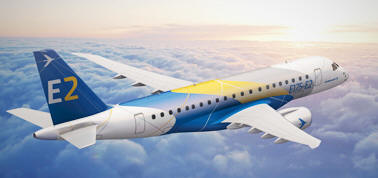
Embraer
Origin: Brazil
Produced: 2019 - today
Length: 32.4 m
Wingspan: 31.0 m
Height: 9.98 m
Aircraft weight:
Max takeoff/landing weight: 44.6 / 40.0 tons
Fuel capacity: 10600 liters
Engines: 2x Pratt & Whitney
PW1700G
Cruising speed: 870 km/h (Mach 0.80)
Maximum speed: 890 km/h (Mach 0.82)
Service Ceiling: 12.5 km (41,000 ft)
Takeoff Run: 1.73 km
Range: 3700 km
Passengers: 80 to 90
First flight: December 2019
Competitors: CRJ-700, CRJ-900, ARJ21, MRJ70, SSJ100
Launch Customer:
Cabin width: 2.74 m
Cabin Height: 2.00 m
Embraer E190-E2
The Embraer E190-E2 is the replacement for the E-190 and remains the
same size. The E190-E2 incorporates new technologies, wings, engines,
avionics and cockpit, allowing up to 16% of fuel consumption reduction.
The E190-E2 also has lower maintenance costs and less noise. After the
first flight tests, Embraer announced that the E190-E2 exceeded
expectations and that the reduction in fuel consumption could reach
17.3%. In addition, the superior performance allowed the aircraft to
increase its maximum range and take-off weight. The fuel economy comes
mainly from the new engines, responsible for 11% reduction. The rest
comes from improvements to the aircraft, where 75% of the systems have
been revamped and the fuselage has been completely redesigned. The
E190-E2 has a cost per trip 7% lower than Bombardier CS100, however the
cost per seat is 1% higher.
In addition, EJets-E2 jets can stay longer period without maintenance,
and can fly up to 1,000 hours before doing intermediate maintenance,
while A320s can fly up to 750 hours. Pilots of the previous generation
need only 2.5 days to adapt to the new generation E2.
For passengers, the cabin has been completely redesigned and features a
new acoustic treatment, a new air conditioning system and more space for
luggage. The cabin of the EJet-E2 Family won the Crystal Cabin Award for
its innovative interior design.
The first delivery took place in April 2018 to the regional Widerøe.
However, after the purchase by Airbus, Embraer jets have suffered strong
competition from the A220 (ex-CS-100/300) and lost important customers
such as JetBlue and Air Canada to Airbus.
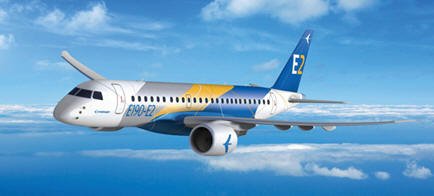
Embraer
Origin: Brazil
Produced: 2018 - today
Length: 36.2 m
Wingspan: 33.7 m
Height: 11 m
Aircraft weight: 33.3 ton
Max takeoff/landing weight: 58.4 / 49.0 tons
Fuel capacity: 17000 liters
Engines: 2x Pratt & Whitney
PW1900G
Cruising speed: 870 km/h (Mach 0.80)
Maximum speed: 890 km/h (Mach 0.82)
Service Ceiling: 12.5 km (41,000 ft)
Takeoff Run: 1.62 km
Range: 5278 km
Passengers: 94 to 114
First flight: May 2016
Competitors: CRJ-900, A220, ARJ21, MRJ70, SSJ100
Launch Customer:
Widerøe
Cabin width: 2.74 m
Cabin Height: 2.00 m
Embraer E195-E2
The Embraer E195-E2 is the largest aircraft ever produced by Embraer and
shall enter into operation in 2019. The E195-E2 is designed to replace
the E-195 and will be larger than the previous version, with three more
rows seats. The E195-E2 will allow Embraer to compete with the C-Series
and even with A320 and Boeing 737. According to Embraer, the E-Jets E2
will have a cost per seat similar to A320neo and B737MAX, with
significantly lower cost per trip. The E195-E2 can achieve a fuel
economy of up to 23% compared to previous models.
The E195-E2 has suffered strong competition from the A220-300
(ex-CS300). Airlines have preferred the Airbus jet because it is larger,
has lower cost per passenger and offers greater range.
Azul was the first airline in the world to receive the E195-E2, in
September 2019. The company chose the model to replace its E-190/195
aircraft.
Operators in Brazil: Azul
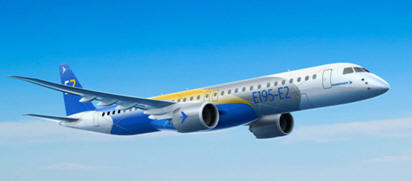
Embraer
Origin: Brazil
Produced: 2019 - today
Length: 41.5 m
Wingspan: 35.1 m
Height: 10.9 m
Aircraft weight:
Max takeoff/landing weight: 61.5 / 54.0 tons
Fuel capacity: 17000 liters
Engines: 2x Pratt & Whitney
PW1900G
Cruising speed: 870 km/h (Mach 0.80)
Maximum speed: 890 km/h (Mach 0.82)
Service Ceiling: 12.5 km (41,000 ft)
Takeoff Run: 1.80 km
Range: 4815 km
Passengers: 118 to 146
First flight: March 2017
Competitors: CRJ-1000, A220, A319neo, Boeing 737 MAX
7
Launch Customer:
Azul
Cabin width: 2.74 m
Cabin Height: 2.00 m
Updated: 2020
